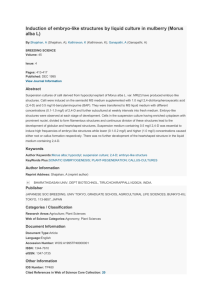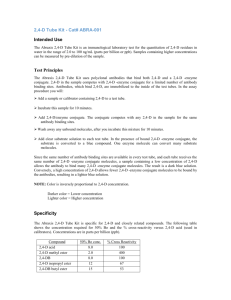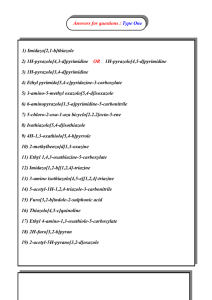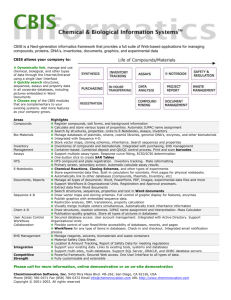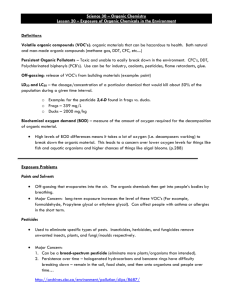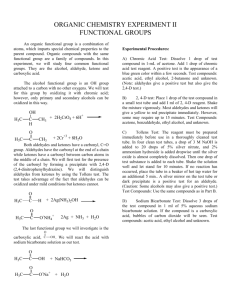H E R B I C I D E F A C T S H E E T 2,4
advertisement
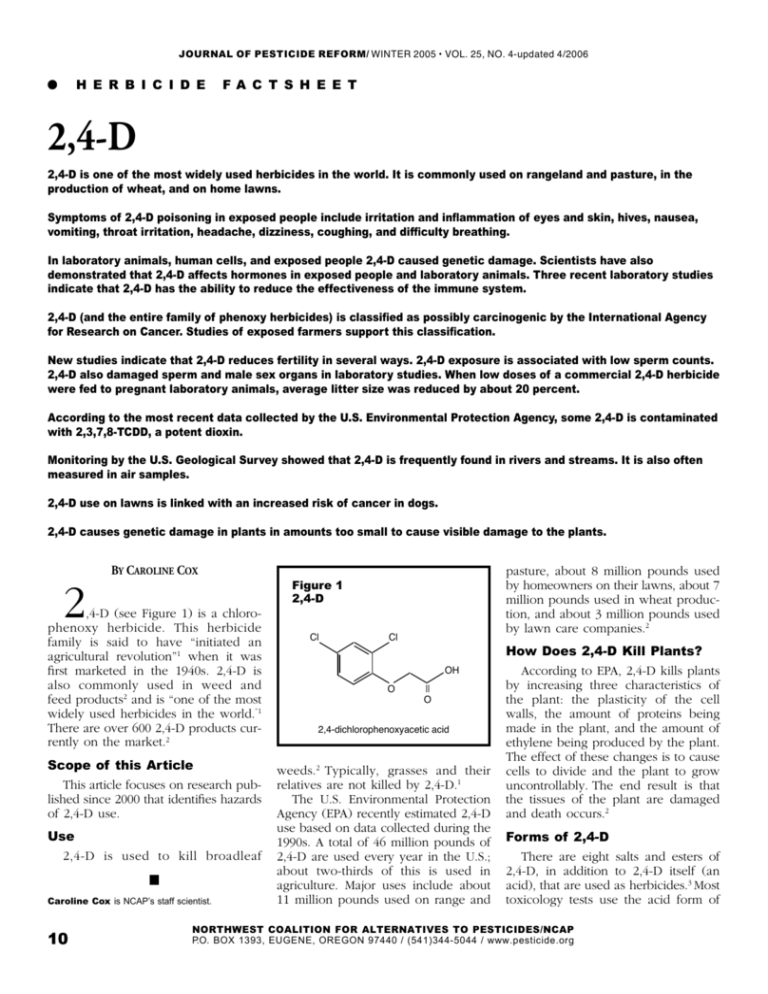
JOURNAL OF PESTICIDE REFORM/ WINTER 2005 • VOL. 25, NO. 4-updated 4/2006 H E R B I C I D E F actsheet 2,4-D 2,4-D is one of the most widely used herbicides in the world. It is commonly used on rangeland and pasture, in the production of wheat, and on home lawns. Symptoms of 2,4-D poisoning in exposed people include irritation and inflammation of eyes and skin, hives, nausea, vomiting, throat irritation, headache, dizziness, coughing, and difficulty breathing. In laboratory animals, human cells, and exposed people 2,4-D caused genetic damage. Scientists have also demonstrated that 2,4-D affects hormones in exposed people and laboratory animals. Three recent laboratory studies indicate that 2,4-D has the ability to reduce the effectiveness of the immune system. 2,4-D (and the entire family of phenoxy herbicides) is classified as possibly carcinogenic by the International Agency for Research on Cancer. Studies of exposed farmers support this classification. New studies indicate that 2,4-D reduces fertility in several ways. 2,4-D exposure is associated with low sperm counts. 2,4-D also damaged sperm and male sex organs in laboratory studies. When low doses of a commercial 2,4-D herbicide were fed to pregnant laboratory animals, average litter size was reduced by about 20 percent. According to the most recent data collected by the U.S. Environmental Protection Agency, some 2,4-D is contaminated with 2,3,7,8-TCDD, a potent dioxin. Monitoring by the U.S. Geological Survey showed that 2,4-D is frequently found in rivers and streams. It is also often measured in air samples. 2,4-D use on lawns is linked with an increased risk of cancer in dogs. 2,4-D causes genetic damage in plants in amounts too small to cause visible damage to the plants. ,4-D (see Figure 1) is a chloro­ phenoxy herbicide. This herbicide family is said to have “initiated an agricultural revolution”1 when it was first marketed in the 1940s. 2,4-D is also commonly used in weed and feed products2 and is “one of the most widely used herbicides in the world.”1 There are over 600 2,4-D products currently on the market.2 Scope of this Article This article focuses on research published since 2000 that identifies hazards of 2,4-D use. Use 2,4-D is used to kill broadleaf Caroline Cox is NCAP’s staff scientist. 10 pasture, about 8 million pounds used by homeowners on their lawns, about 7 million pounds used in wheat production, and about 3 million pounds used by lawn care companies.2 Figure 1 2,4-D Cl Cl OH O — — 2 By Caroline Cox O 2,4-dichlorophenoxyacetic acid weeds.2 Typically, grasses and their relatives are not killed by 2,4-D.1 The U.S. Environmental Protection Agency (EPA) recently estimated 2,4-D use based on data collected during the 1990s. A total of 46 million pounds of 2,4-D are used every year in the U.S.; about two-thirds of this is used in agriculture. Major uses include about 11 million pounds used on range and How Does 2,4-D Kill Plants? According to EPA, 2,4-D kills plants by increasing three characteristics of the plant: the plasticity of the cell walls, the amount of proteins being made in the plant, and the amount of ethylene being produced by the plant. The effect of these changes is to cause cells to divide and the plant to grow uncontrollably. The end result is that the tissues of the plant are damaged and death occurs.2 Forms of 2,4-D There are eight salts and esters of 2,4-D, in addition to 2,4-D itself (an acid), that are used as ­herbicides.3 Most toxicology tests use the acid form of NORTHWEST COALITION FOR ALTERNATIVES TO PESTICIDES/NCAP P.O. BOX 1393, EUGENE, OREGON 97440 / (541)344-5044 / www.pesticide.org JOURNAL OF PESTICIDE REFORM/ WINTER 2005 • VOL. 25, NO.4-updated 4/2006 “Inert” Hazards in 2,4-D Herbicides Chemical Name Health Hazards Identified in Laboratory Tests Compiled by the National Institute for Occupation Safety and Health Amorphous silica Diarrhea, tears, and obstruction of lung blood vessels Attapulgite-type clay Cancer and tumors Aromatic solvent naphtha 1,2-Benzisothiazolin3-one n-Butyl alcohol Butyl cellosolve Diesel Fuel No. 2 Dimethylpolysiloxane Ethylene diaminetetra­ acetic acid Ethylene glycol Hexylene glycol Hydrogenated aliphatic solvent Reduced fertility, reduced litter size, and reduced growth of newborns Genetic damage in human cells, skin sensitization Severe eye irritation, genetic damage in hamsters, reduced fertility, developmental abnormalities; depressed activity Severe eye irritation, genetic damage in bacterial tests, sperm damage, reduced fertility, and developmental abnormalities Tumors Diarrhea Genetic damage in laboratory animals, developmental abnormalities, and reduced fertility Genetic damage in laboratory animals and human cells, developmental abnormalities, reduced litter size, effects on testes, reduced fertility, diarrhea, nausea, headache, reduced liver function, and damage to corneas Severe eye irritation, reduced kidney function Some evidence of cancer in laboratory animals 8-Hydroxyquinoline sulfite Genetic damage in bacterial tests and human cells Kerosene/Fuel Oil No. 1 Skin inflammation Kerosene Methyl oleate Methyl salicilate Mineral spirits Octylphenol polyethoxylate Polyethoxylated isodecyl alcohol Propylene glycol Quartz silica Sodium benzoate Sodium lignosulfonate Titanium dioxide Severe skin irritation, genetic damage in bacterial tests, coughing, nausea, depressed activity, muscle weakness, and anemia Leukemia, tumors Severe skin irritant, reduced newborn survival, reduced fertility, developmental abnormalities,and liver degeneration Kidney damage, skin inflammation, and anemia Genetic damage in human cells and laboratory animals, developmental abnormalities, and skin inflammation Severe skin and eye irritation Genetic damage in laboratory animals, reduced fertility, high blood sugar levels, anemia, and tumors Genetic damage in laboratory animals and human cells, cancer, lung fibrosis, diarrhea, and coughing Genetic damage in laboratory animals and human cells, developmental abnormalities, and reduced newborn survival Genetic damage in laboratory animals, and reduced liver function Genetic damage in laboratory animals, cancer, tumors, and diarrhea Inert ingredients in 2,4-D products identified by EPA Office of Prevention, Pesticides, and Toxic Substances’s Public Information and Records Integrity Branch in response to NCAP’s Freedom of Information Act request RIN-1178-99. Response dated January 28, 2004. Hazards of inert ingredients taken from National Institute for Occupational Safety and Health’s Registry of Toxic Effects of Chemical Substances. Accessed through NISC International, Inc’s BiblioLine Basic Chemical Information System, www.nisc.com. Query done on November, 2005 by Chemical Abstract Services (CAS) numbers 7631-86-9 , 64742-95-6,12174-11-7, 2634-33-5, 71-36-3, 111-76-2, 68476-34-6, 63148-62-9, 60-00-4, 107-21-1, 107-41-5, 64742-47-8, 134-31-6, 8008-20-6, 64742-81-0, 112-62-9, 119-36-8, 8052-41-3, 9002-93-1, 61827-42-7, 57-55-6, 1480860-7, 532-32-1, 8061-51-6, and 13463-67-7. 2,4-D. This article will identify other forms when they are used. Inert Ingredients Most commercial 2,4-D herbicides contain ingredients other than 2,4D. According to U.S. pesticide law, many of these ingredients are called “inert.”4 Typically these ingredients are neither identified on pesticide labels nor included in most of the health and safety ­ testing required to register a ­pesti­­cide.5,6 NCAP has identified some of the inert ingredients used in 2,4-D products through the Freedom of Information Act. For hazards of some of these chemicals, see “‘Inert’ Hazards in 2,4-D Herbicides,” left. Symptoms of 2,4-D Poisoning A review of chlorophenoxy herbicide incidents reported to poison control centers in the U.S. found that about 2,000 poisoning incidents are reported every year. (2,4-D is the most common herbicide in this family.)7 EPA’s summary of 2,4-D poisoning incidents describes the most common symptoms as irritation, inflammation, and itching of eyes and skin. Other symptoms include hives, nausea, vomiting, throat irritation, headache, dizziness, coughing, and difficulty breathing. Eye exposures are more problematic than skin exposures.8 Mutagenicity (Ability to Cause Genetic Damage) In its recent review of 2,4-D, EPA concluded that “2,4-dichlorophenoxyacetic acid was not mutagenic.”9 However, other recent evidence points to a different conclusion: •The National Institute for Occupational Safety and Health labels three forms of 2,4-D (the acid, the sodium salt, and the dimethylamine salt) as mutagens.10 •Research from the University of Minnesota found that the frequency of a chromosome rearrangement in pesticide applicators was correlated with the level of 2,4-D in their urine.11 •Scientists at the Institute for Medical Research and Occupational Health (Croatia) found that a commercial 2,4-D herbicide caused chromosome NORTHWEST COALITION FOR ALTERNATIVES TO PESTICIDES/NCAP P.O. BOX 1393, EUGENE, OREGON 97440 / (541)344-5044 / www.pesticide.org 11 JOURNAL OF PESTICIDE REFORM/ WINTER 2005 • VOL. 25, NO. 4-updated 4/2006 Effects on the Immune System In EPA’s recent review of 2,4-D, the agency asked 2,4-D manufacturers to conduct an additional laboratory test to address concerns about 2,4-D’s toxicity to the immune system.15 However, research has already demonstrated that 2,4-D has significant effects on the immune system: • Led by a toxicologist from the University of Saskatchewan, a team of Canadian researchers showed that exposure to “environmentally realistic” amounts of 2,4-D reduced the activity of at least three human genes that produce proteins with important immune system functions.19 • Scientists from the National Institute for Occupational Safety and Health and West Virginia University showed that 2,4-D decreased the production 12 Carcinogenicity (Ability to Cause Cancer) Whether exposure to 2,4-D causes cancer has been a controversial question for decades. In 1987, the International Agency for Research on Cancer classified all phenoxy herbicides, including 2,4-D, as “possibly carcinogenic to humans.”22 This classification was based primarily on studies of people who were exposed at work to phenoxy herbicides.22 EPA evaluated 2,4-D’s carcinogenicity in 1997 and concluded that 2,4-D is “not classifiable as to human ­carcinogenicity.”23 Meanwhile, research continues to suggest that exposure to 2,4-D poses cancer concerns. One type of research focuses on people who work with 2,4-D. A study led by a scientist from the University of Saskatchewan found that risk of the cancer non-Hodgkin’s lymphoma was increased by exposure to 2,4-D. (See Figure 3.) This study confirms the results of four earlier studies that found a similar link.24 A second study, conducted by an EPA researcher, found that increased cancer rates were associated with phenoxy herbicide use on farms. (This study used wheat acreage to estimate phenoxy herbicide use because 2,4-D and related herbicides are commonly used on wheat.)25 A third study found that exposure to 2,4-D was associated with an increased risk of non-Hodgkin’s lymphoma in California farmworkers. This study was conducted by scientists at the Cancer Registry of Central California.25a Other recent research has focused on how 2,4-D exposure affects cells in ways that promote cancer. A study led by a researcher at St. Louis University showed that rapid and repeated division of blood cells occurs in pesticide applicators who use 2,4-D.26 These results were confirmed by laboratory tests in a study led by a researcher at the University of California, Berkeley.27 A study led by a researcher at the Medical College of Ohio found that 2,4-D increased the activity of a tumor gene in the liver.28 Effects on Sperm Effects of 2,4-D on sperm have been Figure 2 2,4-D and the Immune System 1000 Number of antibody-forming cells in the bone marrow Effects on Hormones EPA’s discussion of 2,4-D’s ability to disrupt the normal functioning of hormones concludes: “Based on currently available toxicity data, which demonstrate effects on the thyroid and gonads [sex organs], there is concern regarding its endocrine disruption ­ potential.”15 This conclusion is based on tests of laboratory animals sponsored by 2,4-D manufacturers showing that 2,4-D decreased levels of thyroid hormones and decreased the size of sex ­organs.16 Other recent research showing that 2,4-D has effects on hormones includes a study of 2,4-D applicators. The study, led by a University of Minnesota researcher, showed that 2,4-D exposure increased levels of a sex hormone in these applicators.11 Another University of Minnesota study shows that two commercial 2,4-D herbicides act like estrogens (sex hormones) in breast cancer cells.17 In addition, a recent study from the Netherlands shows that 2,4-D has the ability to displace sex hormones from the protein that normally transports these hormones in the blood.18 of cells that make antibodies in the bone marrow of mice.20 (See Figure 2.) 2,4-D exposure also decreased the numbers of certain immune system cells made in the thymus.21 500 0 Unexposed Exposed Salazar, K.D. et al. 2005. The polysaccharide antibody response after Streptococcus pneumoniae vaccination is differentially enhanced or suppressed by 3,4-dichloro­­­ propionanilide and 2,4-dichlorophenoxy­ acetic acid. Toxicol. Sci. 87:123-133. In laboratory tests, 2,4-D reduced the production of antibodies, chemicals used to fight off infection. Figure 3 2,4-D and Cancer Risk of non-Hodgkin’s lymphoma (odd’s ratio with 95% confidence interval) breaks in human blood cells.12 •Two studies (from the National ­Research Centre (Egypt) and the Bulgarian Academy of Sciences showed that 2,4-D caused chromosome breaks in mouse bone marrow.13, 14 1.5 1 0.5 0 Unexposed Exposed McDuffie, H.H. et al. 2001. Non-Hodgkin’s lymphoma and specific pesticide exposures in men: Cross-Canada study of pesticides and health. Cancer Epidemiol. Biom. Prev. 10:1155-1163. In a study of Canadian men, exposure to 2,4-D was associated with an increased risk of nonHodgkin’s lymphoma. NORTHWEST COALITION FOR ALTERNATIVES TO PESTICIDES/NCAP P.O. BOX 1393, EUGENE, OREGON 97440 / (541)344-5044 / www.pesticide.org JOURNAL OF PESTICIDE REFORM/ WINTER 2005 • VOL. 25, NO.4-updated 4/2006 Figure 4 2,4-D and Low Sperm Counts Figure 5 2,4-D and Pregnancy Success 0.5 0.4 0.3 0.2 0.1 0 Above ­average sperm counts Below average sperm counts Swan, S.H. 2003. Semen quality in relation to biomarkers of pesticide exposure. Environ. Health Persp. 111:1478-1484. 10 5 0 2,4-D and Birth Defects Risk of birth defects (odd’s ratio for circulatory/respiratory defects with 95% confidence interval) 15 Litter size (with standard deviations) Average 2,4-D exposure (micrograms of 2,4-D in urine per gram of creatinine) 0.6 Figure 6 Unexposed Exposed to lawn care herbicide Cavieres, M.F., J. Jaeger, and W. Porter. 2002. Developmental toxicity of a com­ mercial herbicide mixture in mice: 1. Effects on embryo implantation and litter size. Environ. Health Persp. 110:1081-1085. 3 2 1 0 Low exposure counties High exposure counties Schreinemachers, D.M. 2003. Birth mal­ formations and other adverse perinatal outcomes in four U.S. wheat-producing states. Environ. Health Persp. 111:1259-1264. 2,4-D exposure has been linked with low sperm counts and birth defects. It also reduces fertility in laboratory tests. identified in studies of both exposed people and laboratory animals. A study led by a physician at the University of Missouri compared 2,4-D exposure (as measured by urine 2,4-D levels) with sperm counts. The study found that men with low sperm counts had 2,4-D levels five times as high as those found in men with above average sperm counts.29 (See Figure 4.) In addition, EPA lists a variety of effects on male sex organs that were identified in laboratory tests sponsored by 2,4-D manufacturers. These include atrophy of the testes, degeneration of sperm-producing tissues, and decreased numbers of sperm in the testes.30 2,4-D also caused an increase in the numbers of abnormal sperm in a study conducted at the National Research Centre (Egypt).13 Effects on Children Some of the most troubling concerns about 2,4-D are its potential to harm children: •Pregnancy problems. EPA’s recent review of 2,4-D did not identify significant pregnancy problems caused by 2,4-D exposure except to note that spontaneous abortions increased in rabbits following high-dose exposure.30 However, research from the University of Wisconsin-Madison shows that environmentally relevant exposures to a commercial 2,4-D herbicide reduced litter size in laboratory animals. The study used a lawn care product containing three herbicide chemicals (2,4-D, mecoprop, and dicamba) and an unknown number of inert ingredients. When pregnant animals drank water during their pregnancies containing small amounts of this herbicide, their litters were about 20 percent smaller than litters from animals drinking uncontaminated water.31 (See Figure 5.) •Birth defects: An EPA researcher studying birth defects in rural parts of Minnesota, Montana, North ­ Dakota, and South Dakota showed that defects related to the respiratory and circulatory system were more common in counties with high 2,4-D use than in low-use counties. Wheat acreage was used as an estimate of 2,4-D use.32 (See Figure 6.) •Contaminated breast milk: Two recent studies (one of rats, done at the University of Rosario [Argentina]33 and the other of goats, sponsored by a 2,4-D manufacturer34) show that mothers exposed to 2,4-D produce 2,4-D-contaminated milk. The Ar- gentine study also showed that 2,4-D moved from the milk to the blood and brain of the offspring.33 •Brain development: EPA states that “there is a concern for developmental neurotoxicity resulting from exposure to 2,4-D.”35 (Developmental neurotoxicity is the ability of chemical exposures in the womb or ­ during childhood to affect the developing brain and nervous system.) EPA’s only response to this concern was to require another study from 2,4-D manufacturers.35 However, a series of studies by researchers at the University of Rosario have already demonstrated that 2,4-D exposure impacts brain development. Recent studies show that exposure of laboratory animals during pregnancy and nursing affected neurotransmitters36,37 (the chemicals that allow nerve impulses to move between cells in the brain), reduced brain size,38 and disrupted developing connections between nerve cells in the brain.39 Dioxin Contamination According to EPA, 2,4-D is contaminated with dioxin (2,3,7,8-TCDD),40 a stunningly toxic molecule. 2,3,7,8TCDD, according to the National NORTHWEST COALITION FOR ALTERNATIVES TO PESTICIDES/NCAP P.O. BOX 1393, EUGENE, OREGON 97440 / (541)344-5044 / www.pesticide.org 13 JOURNAL OF PESTICIDE REFORM/ WINTER 2005 • VOL. 25, NO. 4-updated 4/2006 Institute of Occupational Safety and Health, is carcinogenic, mutagenic, and causes reproductive problems at minute doses.41 EPA’s data dates from the 1990s and shows that 2 out of 8 samples of 2,4D analyzed were contaminated with 2,3,7,8-TCDD. Other related dioxins were also found. 2,4-D is the seventh largest source of dioxin in the U.S.40 Dioxins have also been found in a Japanese 2,4-D herbicide.42 Contamination of People According to a survey conducted by the Centers for Disease Control and Prevention, about 25 percent of Americans carry 2,4-D in their bodies. (See Figure 7.) Levels of 2,4-D are higher in children than they are in adults.43 Contamination of Rivers, Streams, and Wells 2,4-D is found in rivers and streams in both agricultural and urban areas. The U.S. Geological Survey’s (USGS’s) national water quality monitoring program found 2,4-D in about 15 percent of the samples the agency collected in agricultural areas. Urban streams were contaminated equally often.44 Wells are also contaminated by 2,4D, according to USGS, but not as often as rivers and streams.45 Contamination of Air USGS compiled air monitoring data from across the country in 1995. The agency found that 2,4-D contamination of air is widespread; almost 60 percent of the samples in the USGS compilation were contaminated with 2,4-D.46 (See Figure 8.) Indoor Contamination Although 2,4-D is used outdoors, it can be tracked inside after lawn care applications and contaminate homes. Researchers from EPA and Battelle Memorial Institute found 2,4-D on dust particles in the air inside homes after lawn treatments, as well as on tables, window sills, and floors.47 Drift Problems Drift of 2,4-D is common. When the Association of American Pesticide Control Officials surveyed state pesticide 14 agencies in 1999, 2,4-D was one of the top five pesticides involved in drift incidents in over 26 states.48 Effects on Pets 2,4-D is linked with both cancer and testicular problems in dogs. Veterinarians from Purdue University studying bladder cancer in Scottish terriers showed that exposure of terriers to lawns treated with phenoxy herbicides is associated with an increased risk of bladder cancer. The risk of this cancer was four times greater in exposed dogs than in unexposed dogs. The results of this study are consistent with an earlier study showing that use of 2,4-D herbicides on lawns was associated with another cancer, lymphoma, in dogs.49 According to laboratory studies sponsored by 2,4-D manufacturers, exposure to 2,4-D also decreases the size of testicles in dogs.50 Effects on Birds Although EPA recently concluded that “risks to birds from 2,4-D exposure are not of concern,”51 2,4-D impacts birds when its use alters the plant community that provides birds with food and shelter. For example, reviews done by USGS Figure 7 regarding the sage-grouse state that “spraying of herbicides [often 2,4-D] not only eliminates large blocks of sagebrush, leading to increased habitat fragmentation, but also may poison insects and other invertebrates eaten by sage-grouse.”52 In another review, USGS noted that 2,4-D spraying caused changes in what Brewer’s sparrows eat, reducing their consumption of insects.53 Effects on Fish EPA requires 2,4-D products to be labeled with a warning about toxicity to fish.54 Recent research shows that some of these toxic effects occur at minute concentrations.55 Researchers at the University of Maryland looked at an effect called “peroxisomal proliferation” in fish. This term refers to an increase in certain specialized cell structures and has been associated with disruptions of sex hormones and development. In this study effects occurred at a concentration of only 10 parts per billion.55 Effects on Frogs EPA’s review of 2,4-D states the 2,4D is “practically non-toxic”56 to frogs. However, recent research shows that 2,4-D has troubling effects on frogs. Figure 8 2,4-D in Our Bodies 2,4-D in Air 2,4-D in a national collection of urine samples 2,4-D in a national compilation of air samples 25% 60% Department of Health and Human Services. Centers for Disease Control and Prevention. 2005. Third national report on human exposure to environmental chemicals. http://www.cdc.gov/exposurereport/. Majewski, M.S. and P.D. Capel. 1995. Pesticides in the atmosphere: Distribution, trends, and governing factors. Chelsea, MI: Ann Arbor Press. Pp. 78-79. A surprising number of Americans carry 2,4-D in their bodies. It is also frequently found in studies of air contamination. NORTHWEST COALITION FOR ALTERNATIVES TO PESTICIDES/NCAP P.O. BOX 1393, EUGENE, OREGON 97440 / (541)344-5044 / www.pesticide.org JOURNAL OF PESTICIDE REFORM/ WINTER 2005 • VOL. 25, NO.4-updated 4/2006 Researchers at Willamette University showed that 2,4-D interferes with a sex hormone and stops frog eggs from maturing.57 Effects on Plants As an herbicide, it is not surprising that 2,4-D damages plants. What is surprising is that 2,4-D can cause genetic damage to plants at concentrations “that did not have any visible physiological effects.”58 Biologists at the University of Lethbridge (Canada) showed that 2,4-D caused mutations in a mustard at concentrations as low as 3 parts per billion, below drinking water guidelines in Canada.58 References 1. Troyer, J.R. 2001. In the beginning: the multiple discovery of the first hormone herbicides. Weed Sci. 49:290-297. 2. U.S. EPA. Prevention, Pesticides, and Toxic Substances. 2005. Reregistration eligibility decision for 2,4-D. http://docket.epa.gov/edkpub/do/EDKStaffIt emDetailView?objectId= 090007d480925518. Pp. 8-10. 3. Ref. #2, pp. 4-6. 4. Federal Insecticide, Fungicide, and Rodenticide Act § 2(a) and 2(m). 5. Code of Federal Regulations §156.10(g) 6. Code of Federal Regulations §158.340 7. Bradberry, S.M., A.T. Proudfoot, and J.A. Vale. 2004. Poisoning due to chlorophenoxy herbicides. Toxicol. Rev. 23:65-73. 8. U.S. EPA. Office of Prevention, Pesticides, and Toxic Substances. 2004. Review of 2,4-D incident reports. Memo from J. Blondell, and M.S. Hawkins, Chemistry and Exposure Branch, to T. Dole, Reregistration Branch. http://docket.epa. gov/edkpub/do/EDKStaffItem DetailView?objectI d=090007d4802c907a. 9. U.S. EPA. Health Effects Div. 2004. Toxicology disciplinary chapter for the reregistration eligibility decision document. http://docket.epa. gov/edkpub/do/EDKStaffItemDetailView?objectId= 090007d4802c9067. p. 32. 10. National Institute for Occupational Safety and Health. 2003-2005. Registry of Toxic Effects of Chemical Substances. Query for Chemical Abstract Services numbers 2008-39-1, 94-75-7, and 2702-72-9 through NISC International, Inc’s BiblioLine Basic Chemical Information System. www.nisc.com. 11. Garry, V.F. et al. 2001. Biomarker correlations of urinary 2,4-D levels in foresters: Genomic instability and endocrine disruption. Environ. Health Persp. 109:495-500. 12. Zeljezic, D. and V. Garaj-Vrhovac. 2004. Chromosomal aberrations, micronuclei and nuclear buds induced in human lymphocytes by 2,4-dichlorophenoxyacetic acid pesticide formulation. Toxicol. 200:39-47. 13. Amer, S.M. and F.A.E. Aly. 2001. Genotoxic effect of 2,4-dichlorophenoxy acetic acid and its metabolite 2,4-dichlorophenol in mouse. Mut. Res. 494:1-12. 14. Venkov, P. et al. 2000. Genotoxic effect of substituted phenoxyacetic acids. Arch. Toxicol. 74:560-566. 15. Ref. #2, p. 21. 16. Ref. # 9, pp. 8, 26. 17. Lin, V. and V.F. Garry. 2000. In vitro studies of cellular and molecular developmental toxicity of adjuvants, herbicides, and fungicides commonly used in Red River Valley, Minnesota. J. Toxicol. Environ. Health A 60:423-439. 18. Meulenberg, E.P. 2002. A new test to identify endocrine disruptors using sex hormone-binding globulins from human serum. Eur. J. Lipid Sci. Technol. 104:131-136. 19. Bharadwaj, L. et al. 2005. Altered gene expression in human hepatoma HepG2 cells exposed to low-level 2,4-dichlorophenoxyacetic acid and potassium nitrate. Toxicol. In Vitro 19:603-619. 20. Salazar, K.D. et al. 2005. The polysaccharide antibody response after Streptococcus pneumoniae vaccination is differentially enhanced or suppressed by 3,4-dichloro­propionanilide and 2,4-dichlorophenoxyacetic acid. Toxicol. Sci. 87:123-133. 21. de la Rosa, P., J.B. Barnett, and R. Schafer. 2005. Characterization of thymic atrophy and the mechanism of thymocyte depletion after in vivo exposure to a mixture of herbicides. J. Toxicol. Environ. Health A 68:81-98. 22. World Health Organization. International Agency for Research on Cancer. 1987. Overall Evaluations of Carcinogenicity: An Updating of IARC Monographs Volumes 1 to 42. Monographs on the Evaluation of Carcinogenic Risks to Humans (Suppl. 7):156. http://www-cie.iarc.fr/htdocs/monographs/suppl7/chlorophenoxyherbicides.html. 23. U.S. EPA. Office of Prevention, Pesticides, and Toxic Substances. 1997. Carcinogenicity peer review (4th) of 2,4- dichlorophenoxyacetic acid (2,4D). Memo from J. Roland and E. Rinde, Health Effects Div. to J. Miller, Registration DIv., and W. Waldrop, Special Review and Reregistration Div. http://www.24d.org/Government%20Review.htm. 24. McDuffie, H.H. et al. 2001. Non-Hodgkin’s lymphoma and specific pesticide exposures in men: Cross-Canada study of pesticides and health. Cancer Epidemiol. Biom. Prev. 10:1155-1163. 25. Schreinemachers, D.M. 2000. Cancer mortality in four northern wheat-producing states. Environ. Health. Persp. 108:873–881. 25a.Mills, P., R. Yang and D. Riordan. 2005. Lymphohematopoietic cancers in the United Farmworkers of America (UFW), 1988-2001. Cancer Causes Cont. 16:823-830. 26. Figg, L.W. et al. 2000. Increased lymphocyte replicative index following 2,4-dichlorophenoxyacetic acid herbicide exposure. Cancer Causes Cont. 11:373-380. 27. Holland, N.T. et al. 2002. Micronucleus frequency and proliferation in human lymphocytes after exposure to herbicide 2,4-dichlorophenoxyacetic acid in vitro and in vivo. Mut. Res. 521:165-178. 28. Ge, R. et al. 2002. Effect of peroxisome proliferators on the methylation and protein level of the c-myc protooncogene in B6C3F1 mice liver. J. Biochem. Mol. Toxicol. 16:41-47. 29. Swan, S.H. 2003. Semen quality in relation to biomarkers of pesticide exposure. Environ. Health Persp. 111:1478-1484. 30. Ref, # 9, p. 4. 31. Cavieres, M.F., J. Jaeger, and W. Porter. 2002. Developmental toxicity of a commercial herbicide mixture in mice: 1. Effects on embryo implantation and litter size. Environ. Health Persp. 110:1081-1085. 32. Schreinemachers, D.M. 2003. Birth malformations and other adverse perinatal outcomes in four U.S. wheat-producing states. Environ. Health Persp. 111:1259-1264. 33. Stürtz, N., A.M. Evangelista de Duffard, and R. Duffard. 2000. Detection of 2,4-dichlorophenoxyacetic acid (2,4-D) residues in neonates breast-fed by 2,4D exposed dams. NeuroToxicology 21:147-154. 34. Barnekow, D.E. et al. 2001. Metabolism of 2,4dichlorophenoxyacetic acid in laying hens and lactating goats. J. Agric. Food Chem. 49:156163. 35. Ref. # 2, p. 19. 36. Bortolozzi, A., R. Duffard, and A.M. Evangelista de 37. 38. 39. 40. 41. 42. 43. 44. 45. 46. 47. 48. 49. 50. 51. 52. 53. 54. 55. 56. 57. 58. Duffard. 2003. Asymmetrical development of the monoamine systems in 2,4-dichlorophenoxyacetic acid treated rats. NeuroToxicology 24:149-157. Bortolozzi, A.A. 2004. Effects of 2,4-dichlorophenoxyacetic acid exposure on dopamine D2like receptors in rat brain. Neurotoxicol. Teratol. 26:599-605. Ferri, A. et al. 2003. Iron, zinc and copper levels in brain, serum and liver of neonates exposed to 2,4-dichlorophenoxyacetic acid. Neurotoxicol. Teratol. 25:607-613. Garcia, G. et al. 2004. Study of tyrosine hydroxylase immunoreactive neurons in neonate rats lactationally exposed to 2,4-dichlorophenoxyacetic acid. NeuroToxicology 25: 951-957. Ref. # 2, pp. 82-83. Ref. #10, query for Chemical Abstract Services No. 1746-01-6. Masunaga, S., T. Takasuga, and J. Nakanishi. 2001. Dioxin and dioxin-like PCB impurities in some Japanese agrochemical formulations. Chemosphere 44:873-885. Department of Health and Human Services. Centers for Disease Control and Prevention. 2005. Third national report on human exposure to environmental chemicals. http://www.cdc.gov/ exposurereport/. U.S. Geological Survey. 2003. Pesticides in streams. Summary statistics; Preliminary results from Cycle I of the National Water Quality Assessment program (NAWQA), 1992-2001. http://ca.water.usgs. gov/pnsp/pestsw/Pest-SW_2001_Text.html U.S. Geological Survey. 2003. Pesticides in ground water. Summary statistics; Preliminary results from Cycle I of the National Water Quality Assessment program (NAWQA), 1992-2001. http://ca.water. usgs.gov/pnsp/pestgw/Pest-GW_2001_Text.html. Majewski, M.S. and P.D. Capel. 1995. Pesticides in the atmosphere: Distribution, trends, and governing factors. Chelsea, MI: Ann Arbor Press. Pp. 78-79. Nishioka, M.G. et al. 2001. Distribution of 2,4-D in air and on surfaces inside residences after lawn applications: Comparing exposure estimates from various media for young children. Environ. Health Persp. 109:1185-191. Assoc. of American Pest Control Officials. 1999. 1999 pesticide drift enforcement survey. http:// aapco.ceris.purdue.edu/doc/surveys/drift99.html. Glickman, L.T. et al. 2004. Herbicide exposure and the risk of transitional cell carcinoma of the urinary bladder in Scottish terriers. J. Am. Vet. Med. Assoc. 2004:1290-1297. Ref. #9, pp. 12-15. Ref. #2, p. 103. Rowland, M.M. 2004. Effects of management practices on grassland birds: Greater SageGrouse. Northern Prairie Wildlife Research Center, Jamestown, ND. http:www.npwrc.usgs. gov/resource/literatr/grasbird/grsg/grsg.htm. Walker, B. 2004. Effects of management practices on grassland birds: Brewer’s Sparrow. Northern Prairie Wildlife Research Center, Jamestown, ND. http:www.npwrc.usgs.gov/resource/literatr/grasbird/brsp/brsp.htm. Ref. #2, p. 113-152. Ackers, J.T., M.F. Johnston, and M.L. Haasch. 2000. Immunodetection of hepatic peroxisomal PMP70 as an indicator of peroxisomal proliferation in the mummichog, Fundulus heteroclitus. Mar. Env. Res. 50:361-365. Ref. #2, p. 60. Stebbins-Boaz, B. et al. 2004. Oocyte maturation in Xenopus laevis is blocked by the hormonal herbicide, 2,4-dichlorophenoxyacetic acid. Mol. Reprod. Dev. 67:233-242. Filkowski, J. et al. 2003. Genotoxicity of 2,4-D and dicamba revealed by transgenic Aradopsis thaliana plants harboring recombination and point mutation markers. Mut. Res. 542:23-32. NORTHWEST COALITION FOR ALTERNATIVES TO PESTICIDES/NCAP P.O. BOX 1393, EUGENE, OREGON 97440 / (541)344-5044 / www.pesticide.org 15
